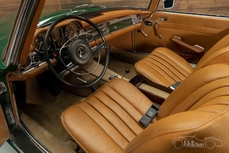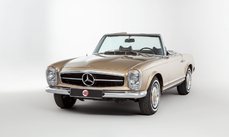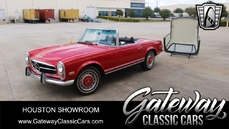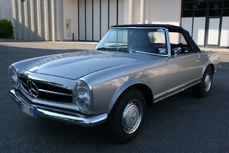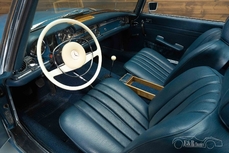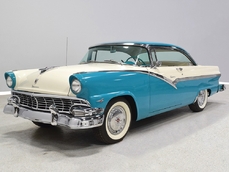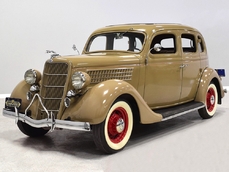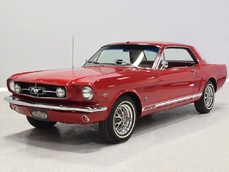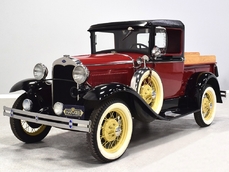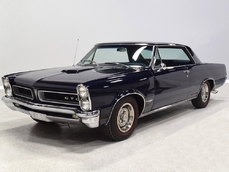Mercedes-Benz 280SL w113 1968
General description :
Things of quality have no fear of time.
That should be our motto here at Harwood Motors. People expect old cars to feel, well, old, but good ones seem immune to the passage of time and few cars are more robust than the immaculately engineered Mercedes W113 “Pagoda” SLs. In a world where everyone seems to want their vintage automobiles to act like modern cars, the 280SL delivers. In spades. This very early production (serial number 000051, engine number 000020, body number 00074) 1968 Mercedes-Benz 280SL, for example, still feels tighter than many modern convertibles and hovers over broken pavement better than my new Cadillac CTS. The engine makes brilliant sounds and the handling is crisp enough to feel contemporary, not dated. All that plus the facts that it’s also bulletproof reliable and extremely easy to use explains why these cars are popular year after year as well as their meteoric rise in value. If you can have only one hobby car, there’s an argument to be made for this 280SL being that car.
Delivered new in Frankfort, Germany in late 1967 (which explains the Euro-spec headlights, bumpers, and metric speedometer) where it remained until 1980 when it was sold to its second owner, an international businessman with offices in both Germany and the US. He shipped it back to the US as a surprise gift for his wife, who used it during summer months until 2011 when it was sold to its third owner, from whom we acquired the car. The car includes detailed ownership records and maintenance receipts showing that the car has always been a cherished toy, never a daily driver, and today it presents in fantastic condition and is ready to drive and enjoy.
The receipts show the car was repainted in 1984 and the rather eye-popping price of $7207 (remember this was 1984 when you could buy a new Ford Mustang for about that much) suggests a very high quality job indeed. It appears that the color was changed from white to silver, but it still has a correct look and most enthusiasts don't regard a repaint to a factory-approved color a demerit. The job was quite thorough, as we can't find any trace of the original white paint anywhere except in the glove box. The quality shows today with only a few blemishes or signs of age and it still glows in the sunlight with just the right amount of metallic in the finish. They did paint over the notches on the front fenders, but they are still barely visible today (it just wasn’t a factor back then) and the doors swing closed with the authority that Mercedes-Benz owners have come to expect. The European styling is how the Pagoda was meant to look, with lovely single-lens headlights, slender bumpers, and uncluttered lines that make these cars so beloved. There’s simply no angle from which it doesn’t look like a movie star. Yes, there are a few signs of use and age, with a few nicks on the nose and behind the rear wheels, but nothing that needs any attention so you can drive and enjoy the car without worries. Accessory chrome fender lip moldings were added at some point, but they are likely removable if they are not to your liking. The rest of the chrome trim is in excellent condition with no notable demerits. Not perfect, but quite nice for being more than 50 years old.
We strongly believe the black MB-Tex interior is original and in fantastic condition. It’s likely that the carpets were replaced at some point, but the door panels, seat covers, and even the dash pad appear to be vintage 1968. The seats remain comfortable and supportive, with just the right firmness to keep you comfortable on long drives. More importantly, all the wood, including that on top of the dash, remains in excellent condition with just some light dryness that could probably be remedied with some linseed oil or other proper treatment. The steering wheel is not cracked or damaged, although as is typical, the hard rubber levers for the ventilation system are broken and will need to be replaced. You will also note that the instruments are metric, including the km/h speedometer (which is not operational), although someone has thoughtfully added stick-on MPH speed indicators on the tachometer to make it easier to figure out how fast you’re going on US roads. There is also an accessory temperature gauge neatly installed in the glove bx to give you a better view of the engine’s condition (don’t worry, it runs ice cold). The original Blaupunkt radio is still in the dash, and it does power up with the power antenna raising at the same time, but we have not been able to tune a station with it, possibly because of its European specification. We believe the folding top is original to the car and was likely blue at some point, although time and sun have faded it to a rather appropriate gray and it’s worth noting that there are no rips, tears, or popped seams, so it remains completely usable. And, of course, a matching hardtop is included, with weather seals and a headliner that are in excellent condition. The trunk is neatly trimmed in matching black carpet with a correct spare tire assembly and a full tool roll included.
The engine is the original 2.8 liter SOHC inline-6 and thanks to a recent service by noted Mercedes-Benz expert Klaus Kitzler, it runs superbly. Receipts show that the engine was rebuilt in 1996, and we estimate that it has been driven fewer than 6000 miles since then (records indicate it had been driven 7616 kilometers between 1996 and 2011, and shortly thereafter the speedometer stopped working). There are signs of conscientious maintenance throughout and the most recent service include a full tune-up plus a fresh fuel injection cold start relay and solenoid, so it starts, runs, and drives beautifully. The 280 got 30 more horsepower over the 250 plus 21 pounds of torque, which makes a big difference in the way this roadster feels on the road. It’s energetic and eager, with a nice hit of torque at any speed and an acceleration curve that feels like it could pull forever. The lusty inline-six makes all kinds of wonderful baritone sounds that recall the great road cars of the ‘50s and ‘60s and it never sounds or feels like it’s working very hard. It’s a joyous machine that feels as eager to have fun as you are.
This one is equipped with the automatic transmission (proudly spelled out on the trunk lid), which is how a vast majority of 280SLs were equipped. There are always going to be guys who turn up their noses at a 2-seat convertible with an automatic transmission, but that completely misses the point of the SL. While it is happy to hustle and feels quite nimble when the road starts to twist, it’s really a fantastic grand tourer that will transport two people great distances in luxury and comfort. Packaged with power steering and powerful 4-wheel disc brakes, this 280SL feels competent, composed, and capable on the road, no matter what it looks like. It’ll hammer across the wastelands of Texas at supra-legal speeds or it’ll hustle through the mountains of Colorado without missing a beat. THAT is the ultimate luxury that an SL represents. As I said, the ride quality is superlative, the exhaust note from the fresh replacement Mercedes-Benz (not a reproduction system!) exhaust system is brilliant, and the brand new 185R14 radials on original steel wheels with color-matched hubcaps ride and handle great.
Documentation is extensive, including a reproduction window sticker, service and restoration receipts, restoration photos, and a copy of the data card from Mercedes-Benz showing that the car does indeed carry its original, numbers-matching engine.
Pagoda SLs continue to be A-list collectibles, a trend we expect to continue for the foreseeable future. They combine great looks, superlative road manners, and daily-driver usability into one of the most appealing collector cars you can own. You can get in this car for a spirited Sunday drive or a long-distance trip across the country, it does both equally well. If you can have just one collector car, there’s a strong argument to be made that this be it. Call today!
http://www.harwoodmotors.com/vehicles/inventory_details.php?id=984
1968 Mercedes-Benz 280SL w113 is listed sold on ClassicDigest in Macedonia by for $69900.
Car Facts
Car type : Car Make : Mercedes-Benz Model : 280SL w113 Engine size : 2.8 Model Year : 1968 Sub type : Convertible Location : Ohio
Sold
Seller Information
Sold
People who viewed this Mercedes-Benz 280SL w113 also viewed similar Mercedes-Benz listed at ClassicDigest
Other cars listed for sale by this dealer
About Mercedes-Benz
In the annals of automotive history, the journey of Mercedes-Benz is a tale that unfolds with the ingenuity of its founding pioneers. In the year 1886, Karl Benz crafted the Benz Patent Motorwagen, a creation that would go down in history as the world's inaugural automobile. Unbeknownst to him, this moment marked the genesis of what would evolve into the most illustrious premium car manufacturer globally. The financial underpinning of this pioneering venture, interestingly, was provided by Karl Benz's wife, Bertha Benz, demonstrating a remarkable partnership that would set the tone for Mercedes-Benz's legacy.A parallel narrative emerged not far away, as Daimler-Motoren-Gesellschaft, founded by Gottlieb Daimler and Wilhelm Maybach, entered the scene. In 1901, they unveiled their automobile under the now-famous moniker "Mercedes," meaning "godsend" in Spanish. This name was bestowed upon the car at the behest of Emil Jellinek's daughter, the distributor for Daimler-Motoren-Gesellschaft. The wheels of innovation were set in motion.
Fast forward to 1926, a pivotal year that witnessed the merger of Daimler with Benz & Cie., culminating in the birth of Daimler-Benz. The amalgamation saw the adoption of "Mercedes-Benz" as the distinguished trademark for their automobiles, fusing the legacies of two visionary entities into one.
Contrary to perceptions of conservatism, the trajectory of Daimler-Benz unfolds as a chronicle of industry firsts. From the introduction of the honeycomb radiator to the float carburetor, and the pioneering implementation of four-wheel brakes in 1924, Daimler-Benz consistently pushed the boundaries of automotive innovation. The diesel-powered Mercedes-Benz 260 D in 1936 marked the inception of diesel engines in passenger cars. The iconic Mercedes-Benz 300SL Gullwing made history as the first car with direct fuel injection, albeit the Gutbrod's tiny 2-stroke engine can claim precedence.
Safety innovations became a hallmark, with Béla Barényi's patented safety cell design in the "Ponton"-models in 1951, featuring front and rear crumple zones. The W116 450SEL 6.9 saw the introduction of the Anti-Lock Brake system (ABS), another pioneering safety feature. From the first production airbags and beyond, the legacy of "firsts" continued to be etched into the fabric of Daimler-Benz.
Over its centennial journey, Mercedes-Benz has not merely produced cars but has sculpted automotive icons. The SSKL, 710 SSK Trossi Roadster, 770K Grosser, 540K Spezial Roadster, 300SL Gullwing, w100 600 Pullman, w111 280SE 3.5 Flachkühler, w113 230SL Pagoda, w109 300 SEL 6.3, and w201 2.3-16 Cosworth stand testament to the brand's commitment to engineering excellence.
The roaring Silver Arrows, or "Silberpfeile," including the W 25, W 125, W154, W165, and W196, created a legacy of dominance on the racetrack. These machines were not merely cars; they were expressions of precision, speed, and an indomitable spirit that left their competitors in the dust.
As Mercedes-Benz marches into the future, it does so not just as an automaker but as a custodian of a legacy, a torchbearer of innovation, and a beacon of automotive excellence. The road ahead is sure to witness the continued fusion of cutting-edge technology, timeless design, and an unwavering commitment to setting new standards in the world of automobiles.
One luminary figure who left an indelible mark was Béla Barényi, often heralded as the "father of passive safety" for his pioneering work in safety engineering. His patented safety cell design, featuring front and rear crumple zones, became a hallmark of Mercedes-Benz's commitment to occupant safety, setting new standards that reverberated throughout the automotive world.
Moving through the chronicles, the collaborative genius of Wilhelm Maybach, alongside Gottlieb Daimler, laid the foundation for Daimler-Motoren-Gesellschaft. Their innovations not only birthed the first Mercedes but established a culture of relentless pursuit of technological excellence that remains integral to Mercedes-Benz's DNA.
In the post-merger era of 1926, Ferdinand Porsche emerged as a prominent figure within Mercedes-Benz. His work on the Mercedes-Benz S-Type, a supercharged race car, garnered acclaim and set the stage for a legacy that extended far beyond the marque. Porsche's impact would later extend to his eponymous company, but his influence at Mercedes-Benz during those formative years was pivotal.
As the 20th century progressed, the legendary Rudolf Uhlenhaut emerged as a key figure. Uhlenhaut, an accomplished engineer and the driving force behind the iconic Silver Arrows, played a crucial role in Mercedes-Benz's dominance in motorsports. His engineering prowess and attention to detail were instrumental in creating some of the most formidable racing cars of the era.
In the latter half of the century, figures like Bruno Sacco, the head of design at Mercedes-Benz from 1975 to 1999, left an indelible imprint on the brand's aesthetic identity. Sacco's design philosophy, characterized by clean lines and timeless elegance, shaped iconic models like the W126 S-Class and the W201 190E, solidifying Mercedes-Benz's reputation for luxury and sophistication.
The narrative would be incomplete without acknowledging the contributions of engineers like Hans Scherenberg, whose leadership in the 1970s ushered in a new era of technological innovation at Mercedes-Benz. Scherenberg's tenure saw the development of groundbreaking technologies, including the Anti-Lock Brake system (ABS) and the introduction of airbags in production cars.


